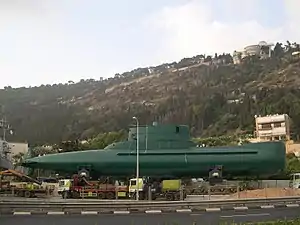Clandestine Immigration and Naval Museum



The Clandestine Immigration and Naval Museum (Hebrew: מוזיאון ההעפלה וחיל הים ע"ש דוד הכהן) is a technical history museum located in Haifa, Israel.
The museum covers the maritime history of Israel – from clandestine immigration during the British Mandate for Palestine through the history of the Israeli navy since its inception.
The museum is named after David HaCohen, one of the leaders of the Jewish Yishuv. It was established by Colonel Yoske Coral and opened to the public in 1969. The museum is run by the Israeli Ministry of Defense. It stands next to the Israeli National Maritime Museum, dedicated to maritime history and archaeology.
Exhibits
Remnants of the INS Dakar, an Israeli submarine that disappeared on its voyage to Israel in 1968 and whose wreckage was located in 1999 after several decades of searches, are on display at the museum.[1] The following vessels are on permanent display:
- INS Mivtach, a decommissioned Sa'ar 2-class missile boat
- INS Gal, a retired Gal-class submarine
- INS Af Al Pi Chen, a clandestine immigration ship, built as a Royal Navy Mark 2 Tank Landing Craft in World War II[2]
The museum also displays the wheel and bell of MTB-203, the motor torpedo boat which launched the fatal torpedo at the USS Liberty during the 1967 USS Liberty incident, killing 25 U.S. Navy sailors.[3][4][5] Also on display at the museum is one of the three lifeboats that the USS Liberty launched during the attack.[4][5] The other two lifeboats were, according to multiple Liberty survivors, machine-gunned and sunk by Israeli motor torpedo boats.[6][7][8][9][10][11][12]
See also
References
- "Stairway to Haifa". Haaretz.
- "INS Af Al Pi Chen". Historic Naval Ships Association. Retrieved 16 September 2016.
- https://www.wrmea.org/2003-september/friendless-fire-article-for-liberty-article-in-this-issue.html
- McGovern, Ray (July 5, 2015). "Still Waiting for USS Liberty's Truth". The Real News Network.
- "Still Waiting for USS Liberty's Truth". July 4, 2015.
- Scott, James (2009). The Attack on the Liberty: The Untold Story of Israel's Deadly 1967 Assault on a U.S. Spy Ship. Simon and Schuster. ISBN 978-1416554820 – via Google Books.
- Ennes, James M. (1979). Assault on the Liberty: The True Story of the Israeli Attack on an American Intelligence Ship. Random House. ISBN 978-0394505121 – via Google Books.
- "The Spy Ship Left Out in the Cold". U.S. Naval Institute. June 1, 2017.
- "New revelations in attack on American spy ship". Chicago Tribune. October 2, 2007.
- "New revelations in attack on American spy ship". Baltimore Sun. October 2, 2007.
- https://www.usslibertyveterans.org/files/Lloyd%20Painter%20Affidavit.pdf
- https://www.usslibertyveterans.org/files/GlennOliphant.pdf
External links
![]() Media related to Clandestine Immigration and Naval Museum, Haifa at Wikimedia Commons
Media related to Clandestine Immigration and Naval Museum, Haifa at Wikimedia Commons